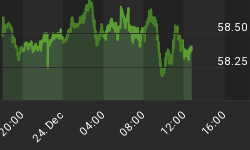Recently voiced concerns from the Chinese government that their surging domestic stock market was crossing into bubble territory helped to set off last week's sharp decline, including a single day plunge of 6.5% (the equivalent of more than 800 points on the Dow Jones.) While a bubble may indeed be forming in Chinese stocks, my guess is that there is room for a lot more air before it finally pops.
In fact, the recent warnings in China are reminiscent of Alan Greenspan's infamous "irrational exuberance" speech in December of 1996. As history has shown, the Chairman was correct (perhaps for the only time in his tenure), but Greenspan failed to comprehend just how much irrationality the markets would bear before they finally gave in. In fact, after nearly four more years of unprecedented market exuberance, Greenspan himself took the "new era" bait hook, line and sinker. Surprisingly, he became one of the market's greatest cheerleaders. My guess is that before a similar peak is reached in China, officials there will be snared on the same line.
Just as the bubble in U.S. stocks resulted from the inflationary monetary policies of the Fed, the bubble in Chinese shares is being created by the inflationary policies of the Bank of China. However, as Chinese authorities are creating yuan mainly to buy U.S. dollars, the Fed is in effect the driving force behind this bubble as well. As we export our inflation to Asia, the Chinese stock market bubble may be one of the few things in Asia that was actually "Made in the U.S.A."
One major difference between the rise in the Chinese market in 2007 and the U.S. in 1997 is that much of the rise in China is actually justified by the fundamentals. Unlike the U.S., not all of the liquidity is the result of inflation. Much of it comes from the savings of millions of under-consuming Chinese workers, whose combined sacrifice has enabled business to finance capital investment that has led to enhanced productivity, greater earnings, and higher share prices. Liquidity produced by savings is genuine and the fact that it fuels legitimate investment is one of its primary benefits.
However, liquidity provided by central banks is false as it produces only malinvestment which must be liquidated in the busts that inevitably follow inflationary booms. The fact that inflation sometimes lifts asset prices before lifting consumer prices is one of the main reasons that it is so intoxicating and so dangerous.
Perhaps no one expressed it better than Alan Greenspan himself, when in 1996 he wrote the following with respect to U.S. Fed policy during the 1920's.
When business in the United States underwent a mild contraction in 1927, the Federal Reserve created more paper reserves in the hope of forestalling any possible bank reserve shortage. More disastrous, however, was the Federal Reserve's attempt to assist Great Britain who had been losing gold to us because the Bank of England refused to allow interest rates to rise when market forces dictated (it was politically unpalatable). The reasoning of the authorities involved was as follows: if the Federal Reserve pumped excessive paper reserves into American banks, interest rates in the United States would fall to a level comparable with those in Great Britain; this would act to stop Britain's gold loss and avoid the political embarrassment of having to raise interest rates. The excess credit which the Fed pumped into the economy spilled over into the stock market-triggering a fantastic speculative boom. Belatedly, Federal Reserve officials attempted to sop up the excess reserves and finally succeeded in braking the boom. But it was too late: by 1929 the speculative imbalances had become so overwhelming that the attempt precipitated a sharp retrenching and a consequent demoralizing of business confidence. As a result, the American economy collapsed. Great Britain fared even worse, and rather than absorb the full consequences of her previous folly, she abandoned the gold standard completely in 1931, tearing asunder what remained of the fabric of confidence and inducing a world-wide series of bank failures. The world economies plunged into the Great Depression of the 1930's.
Substitute the United States for Great Britain, and China, Japan, and the rest of Asia for the United Sates, and it's the same situation all over again. Back then, Great Britain was the declining power and America was the emerging one. Today the sun is setting on American dominance just as it is rising in the East. In the end, the 1929 Fed recognized the error of its ways and allowed the pound to fall. Soon Asian central banks will reach similar conclusions. When they do, just as America once replaced Britain as the world's dominant economic power, the Asian block will supplant America. During the prior transition the world suffered through the Great Depression and the Second World War. Though the current transition may be somewhat less traumatic, its implications will be just as earth shattering.
For a more in depth analysis of the precarious state of the American economy and its dependence on Asia order a copy of my new book "Crash Proof: How to Profit from the Coming Economic Collapse" by clicking here.
In addition, protect your wealth and preserve your purchasing power before it's too late. Discover the best way to buy gold at www.goldyoucanfold.com, download my free research report on the powerful case for investing in foreign equities available at www.researchreportone.com, and subscribe to my free, on-line investment newsletter at http://www.europac.net/newsletter/newsletter.asp.
















